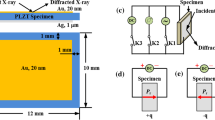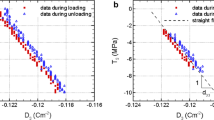Abstract
Electric fatigue and radiation damage may induce pinched polarization hysteresis loops and asymmetric strain hysteresis loops of ferroelectric ceramics, respectively. Based on a gradual domain switching model, this paper formulates a novel constitutive model to investigate the hysteresis deformation behavior of ferroelectric ceramics by radiation damage and electric fatigue. First, two important physical mechanisms, namely, alignment of the defect dipoles and domain-wall pinning due to diffusion of charged defects, are considered in irradiated ferroelectric ceramics. It is found that the alignment of the defect dipoles acts as an internal field and increases the coercive field, while the domain-wall pinning clamps the domain and causes the vanishment of remanent polarization. Second, the effects of point defects and domain pinning by space charges are taken into account in ferroelectric fatigue model. The results of simulations reveal that the spatial distribution and electric property of space charges play a dominant role in the asymmetry of strain hysteresis loops. The proposed model can elucidate experimental phenomena reported in the literature.








Similar content being viewed by others
References
Chynoweth AG (1959) Radiation damage effects in ferroelectric triglycine sulfate. Phys Rev 113(1):159–166. doi:10.1103/PhysRev.113.159
Damjanovic D (1998) Ferroelectric, dielectric and piezoelectric properties of ferroelectric thin films and ceramics. Rep Prog Phys 61:1267–1324. doi:10.1088/0034-4885/61/9/002
Lines ME, Glass AM (1977) Principles and applications of ferroelectrics and related materials. Clarendon Press, Oxford
Lupascu DC (2004) Fatigue in ferroelectric ceramics and related issues. Springer, Heidelberg
Morozovska AN, Eliseev EA (2005) Phenomenological description of polarization switching in ferroelectric semiconductors with charged defects. Phys Status Solidi 242(4):947–961. doi:10.1002/pssb.200402107
Ozgul M et al (2004) Influence of electrical cycling on polarization reversal processes in Pb(Zr1/3Nb2/3)O3–PbTiO3 ferroelectric single crystals as a function of orientation. J Appl Phys 85:4296–4302. doi:10.1063/1.1687046
Ren XB (2004) Large electric-field-induced strain in ferroelectric crystals by point-defect-mediated reversible domain switching. Nat Mater 3:91–94. doi:10.1038/nmat1051
Robert G et al (2000) Preisach modeling of ferroelectric pinched loops. Appl Phys Lett 77(26):4413–4415. doi:10.1063/1.1332824
Singh RN (2003) Large strain ceramics based on electric field-induced antiferroelectric–ferroelectric phase transformation in Sr-modified PZT. Ferroelectrics 293:219–229. doi:10.1080/00150190390238432
Tamura T et al (1999) Hysteresis variations of (Pb, La) (Zr, Ti)O3 capacitors baked in a hydrogen atmosphere. Appl Phys Lett 74(22):3395–3397. doi:10.1063/1.123356
Uchino K (2000) Ferroelectric devices. Marcel-Dekker, New York
Warren WL et al (1996) Defect-dipole alignment and tetragonal strain in ferroelectrics. J Appl Phys 79:9250–9257. doi:10.1063/1.362600
Yu L et al (2007a) Effects of electric fatigue on the butterfly curves of ferroelectric ceramics. Mater Sci Eng A 459:273–277. doi:10.1016/j.msea.2007.01.063
Yu L et al (2007b) A simple constitutive model for ferroelectric ceramics under electrical/mechanical loading. Acta Mech Solida Sin 20(1):1–12
Yu Y, Singh RN (2001) Phase stability and ferroelectric properties of lead strontium zirconate titanate ceramics. J Am Ceram Soc 84(2):333–340
Yu Y, Singh RN (2003) Electrical properties and electric field-induced antiferroelectric–ferroelectric phase transition in Nd3+-doped lead strontium zirconate titanate ceramics. J Appl Phys 94(11):7250–7255. doi:10.1063/1.1620678
Zhang Y et al (2005) Heterogeneity of fatigue in bulk lead zirconate titanate. Acta Mater 53:2203–2213. doi:10.1016/j.actamat.2005.01.048
Acknowledgment
This project supported by NSFC (Nr.10572067,10772093) and NBRPC-973 program 2007CB936803.
Author information
Authors and Affiliations
Corresponding author
Rights and permissions
About this article
Cite this article
Yu, S., Yu, L. Effects of fatigue and damage on the hysteresis loops of ferroelectric ceramics. Microsyst Technol 15, 33–38 (2009). https://doi.org/10.1007/s00542-008-0691-3
Received:
Accepted:
Published:
Issue Date:
DOI: https://doi.org/10.1007/s00542-008-0691-3




